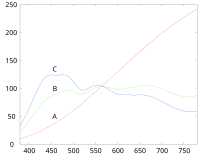
Photo from wikipedia
Abstract We have investigated via Judd-Ofelt (JO) analysis a new system of PbO, ZnO based P2O5 glass in metaphosphate regime spanning a range of Er3+ doping concentration, 0.6–1.0 mol %. The… Click to show full abstract
Abstract We have investigated via Judd-Ofelt (JO) analysis a new system of PbO, ZnO based P2O5 glass in metaphosphate regime spanning a range of Er3+ doping concentration, 0.6–1.0 mol %. The results are compared between as prepared (unannealed) and annealed samples to converge to the optimum doping regime for laser emission. Using the JO parameters, doping dependence of spontaneous emission probability (A), lifetime of excited state ( τ R ) and luminescence branching ratio (β) of Er3+ have been investigated. The largest value of τ R = 15.9 ms is achieved for 4I13/2 state in 1% Er doped as prepared sample. Such a value of τ R is ~3.5 times larger than those for other Er3+ doped glass systems. A parameter (χ) suitable to compare between 4I11/2 → 4I15/2 and 4I13/2 → 4I15/2 transitions in Er3+ has been proposed. Along with the largest magnitude of τ R , the maximum value of χ occurs at the same doping level of 1% in unannealed sample. For 4I13/2 → 4I15/2 emission, 100% of β value occurs. It is shown that all these conditions together with χ > 1 lead to the conclusion that 4I13/2 → 4I15/2 transition (1540 nm) will dominate over 4I11/2 → 4I15/2 emission (987 nm). In the admixed laser emission, 1540 nm component will be the largest at 1 mol % doping for unannealed sample.
Journal Title: Materials Chemistry and Physics
Year Published: 2020
Link to full text (if available)
Share on Social Media: Sign Up to like & get
recommendations!